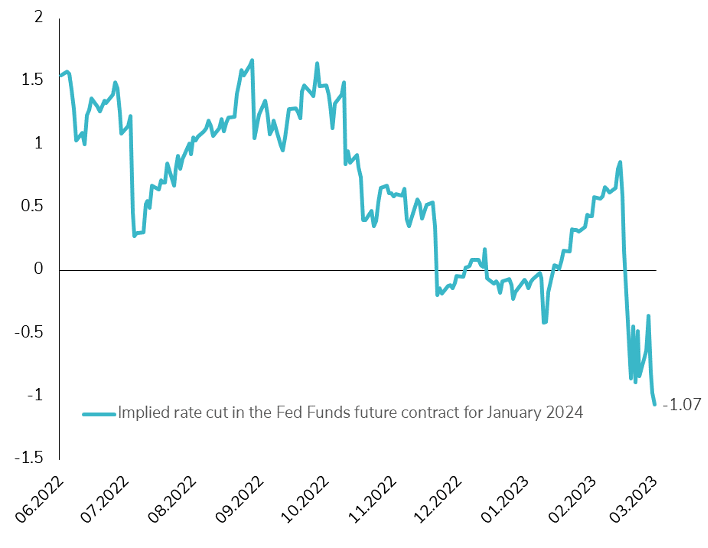What happened last week?
Central banks: What if the Federal Reserve (Fed) raised its Funds rates for the last time this cycle? Indeed, Fed Chairman Powell released the latest FOMC decisions, which raised the Federal Funds rate by 25 bps to 5% and announced that quantitative tightening would continue as planned. But the market is forcing the central bank to reconsider its position, as it expects a 100 bps cut within a year and strongly doubts a further tightening move in May. In Europe, the SNB (+50bps to 1.5%), Norges Bank (+50bps to 3.0%) and the BOE (+25bps to 4.25%) all raised their key rates, leaving the door open for further increases, convinced that their economies will avoid recession in 2023 and still concerned about inflation risks.
Rates: The yield on 10-year U.S. Treasuries ended the week almost unchanged (-3bps) to 3.38%. The front end of the yield curve fell by 7 bps, reinforcing the steepening that started at the beginning of the month. It is worth noting that we are on the verge of the largest monthly steepening of the US yield curve since October 2008! The spread between the 30-year and 5-year U.S. Treasury yields turned positive last week, while the spread between the 10-year and 2-year has increased 70 bps since its March 8 low. The MOVE index, a measure of volatility in U.S. Treasury rates, remains at a very high level, closing the week at 174 bps. In Europe, despite extreme swings (i.e., a 70bps range between the week's low and high), rates were virtually unchanged over the week. The German 2-year yield ended the week at 2.39% (unchanged) while the 10-year rose 2bps to 2.13%. Peripheral rates benefited from the weekly rise in risk assets, with the Italian 2-year yield falling 12bps, while the difference between the Italian and German 10-year yields fell 6bps to 188bps.
Credit: The risk appetite for the best quality segment of the credit market has pushed Investment Grade (IG) corporate spreads to ended the week almost 10bps lower to 149bps. This is the main explanation of another positive weekly gain (+0.9%) in IG, the fourth positive week in a row. Positive investor sentiment toward high-quality paper has revived the primary market, where more than $20 billion has been printed due to strong demand. In the high yield (HY) sector, bonds stabilized with a slight positive gain, but spreads widened slightly again during the week (+7bps). In Europe, credit indices ended the week in green, with a slight tightening of IG spreads, while high yield spreads widened slightly. But obviously the main topic was about the UBS/Credit Suisse story which saw $16bn of AT1 wiped out while the Credit Suisse equity shareholders received more than $3bn. Please find more on the topic here: https://blog.syzgroup.com/slow-food-for-thoughts/should-we-still-be-in-love-with-the-cocos .
Emerging market: Emerging market corporate bonds were slightly positive last week (+0.1%). But the deterioration continues, with credit spreads on the Bloomberg EM Corporate bonds index closing the week above 400 basis points for the first time in 2023. Investors continue to focus on high quality EM bonds, with Asian IG bonds posting its fourth consecutive weekly gain, while Asian high yield, led by Chinese real estate, continued to struggle and posted its third consecutive weekly loss. In Latin American, Credit Default Swaps (CDS) were largely unchanged, but Peruvian CDS rose 6 bps ahead of the Peruvian Congress' decision (Thursday) on whether to approve a motion to discuss the impeachment of President Boluarte.



.png)
